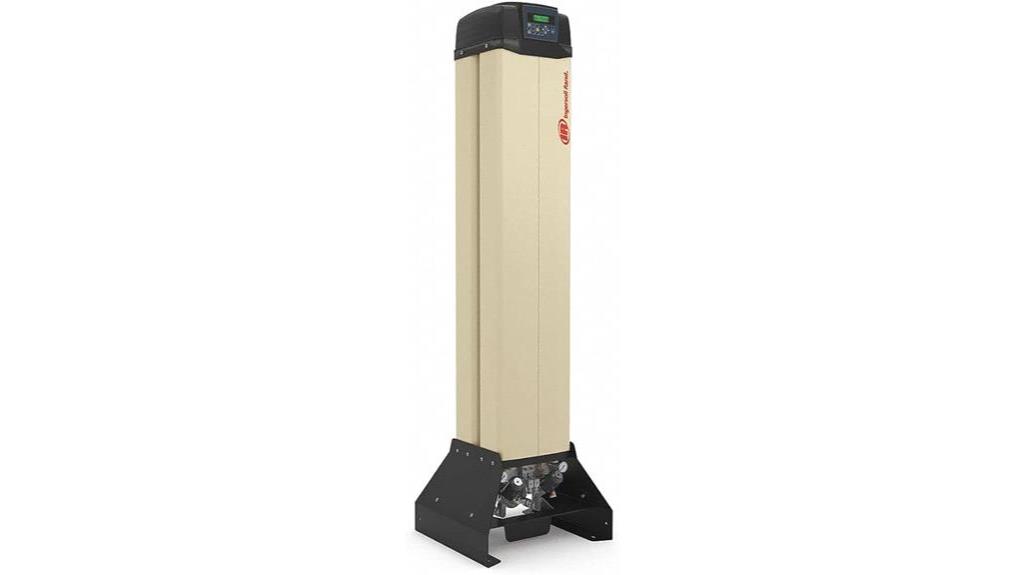If you’re looking for the best Mac minis for software development in 2025, I recommend models with the M4 or M4 Pro chips. The M4 offers solid power with a 10-core CPU and GPU, great for most tasks, while the M4 Pro delivers even more performance with extra cores and support for multiple displays. Upgrading RAM and storage upfront guarantees future-proofing. Keep an eye on these options, and you’ll find the perfect match for your needs. More details ahead.
Key Takeaways
- The Mac mini with M4 Pro offers the highest CPU and GPU performance, ideal for demanding development workflows.
- All models support multiple high-resolution displays, enhancing multitasking and testing environments.
- Configuring at least 16GB RAM and a 512GB or larger SSD ensures smooth performance and future-proofing.
- Thunderbolt, HDMI, and USB-C ports provide versatile connectivity for peripherals and external drives.
- Investing in higher-spec models balances power, performance, and long-term value for software development in 2025.
Apple 2024 Mac mini Desktop Computer with M4 Chip
If you’re looking for a compact yet powerful machine for software development, the Apple 2024 Mac mini with the M4 chip is an excellent choice. Its small aluminum design measures just 5 inches square and weighs only 1.5 pounds, making it highly portable and space-efficient. Despite its size, it offers robust connectivity with Thunderbolt 4, HDMI, Ethernet, and USB-C ports. Powered by the M4 chip, it delivers a significant performance boost with a 10-core CPU, 10-core GPU, and improved AI capabilities. With 16GB of memory and fast SSD storage, it handles multitasking, coding, and media tasks smoothly, all while maintaining a quiet, energy-efficient operation.
Best For: software developers, creative professionals, and users seeking a compact yet powerful desktop for multitasking and media workflows.
Pros:
- Small, space-efficient aluminum design with high portability
- Powerful M4 chip with a 10-core CPU and GPU for demanding tasks
- Supports multiple high-resolution external displays and seamless connectivity
Cons:
- Lack of USB-A ports requiring adapters for some peripherals
- Power button placement at the bottom may be less intuitive
- Base configuration with 16GB memory might be limited for very demanding workflows
Apple 2024 Mac mini Desktop Computer with M4 Chip
The Apple 2024 Mac mini with the M4 chip stands out as an ideal choice for software developers who need powerful performance in a compact form factor. Its small footprint, measuring just 5×5 inches, makes it easy to fit next to monitors or in tight spaces. Powered by the M4 chip with a 10-core CPU and GPU, plus 16GB of unified memory, it delivers snappy, fluid performance for demanding tasks. With versatile ports like Thunderbolt, HDMI, and Gigabit Ethernet, as well as front-facing USB-C and a headphone jack, it offers seamless connectivity. Perfect for developers seeking a high-performance, space-saving machine that integrates smoothly into the Apple ecosystem.
Best For: software developers and tech enthusiasts seeking a compact, high-performance desktop that integrates seamlessly into the Apple ecosystem.
Pros:
- Compact size fits easily in tight spaces or next to monitors
- Powerful M4 chip with 10-core CPU and GPU delivers fast, responsive performance
- Versatile connectivity options including Thunderbolt, HDMI, and Gigabit Ethernet
Cons:
- Limited storage options starting at 256GB SSD may require external solutions for large files
- No dedicated graphics card, which could impact high-end graphical tasks
- May be overpowered for casual users who don’t need high processing capabilities
Apple Mac mini Desktop Computer with M4 Pro chip
For software developers seeking a compact yet powerful desktop, the Apple Mac mini with the M4 Pro chip stands out as an excellent option. Its small 5×5-inch size and lightweight design make it perfect for tight spaces, while still offering impressive performance. The M4 Pro chip boosts CPU speed by 20% and GPU performance by up to 14%, handling demanding tasks like coding, testing, and media processing with ease. It supports up to three high-resolution displays, including 8K, and offers extensive connectivity, including Thunderbolt 5 and HDMI. With up to 64GB of RAM and fast SSD storage, this Mac mini delivers power, efficiency, and seamless integration into the Apple ecosystem.
Best For: software developers and creative professionals seeking a compact, high-performance desktop with extensive display support and seamless Apple ecosystem integration.
Pros:
- Compact design with powerful M4 Pro chip performance for demanding tasks
- Supports up to three high-resolution displays, including 8K, ideal for multitasking and creative workflows
- Quiet operation with excellent energy efficiency and fast connectivity options
Cons:
- Lack of USB-A ports, requiring adapters for some peripherals
- Less intuitive power button placement at the bottom of the device
- Base models include limited memory (24GB), which may restrict intensive multitasking without upgrades
Apple Mac mini Desktop Computer with M4 Chip (2024)
Designed around Apple silicon, the 2024 Mac mini with M4 chip delivers exceptional performance in a compact package, making it ideal for software developers who need power without sacrificing space. Equipped with a 10-core CPU and GPU, 24GB of unified memory, and a 512GB SSD, it handles demanding tasks smoothly. Its five-by-five-inch design fits easily beside monitors or in tight spaces. With versatile ports like Thunderbolt, HDMI, Gigabit Ethernet, and front USB-C, connectivity is effortless. Built for the Apple ecosystem, it integrates seamlessly with iPhone and iPad, enhancing productivity and security for developers on the go.
Best For: software developers and tech enthusiasts seeking a powerful, compact desktop with seamless ecosystem integration and advanced performance capabilities.
Pros:
- Compact size fits easily in tight spaces and next to monitors
- Powerful M4 chip with 10-core CPU and GPU for demanding tasks
- Versatile connectivity options including Thunderbolt, HDMI, and Gigabit Ethernet
Cons:
- Limited storage options starting at 512GB SSD may require external drives for large files
- No dedicated graphics card, which might be a concern for high-end gaming or specific graphic-intensive tasks
- Price point may be higher compared to other mini desktop options with similar specs
Factors to Consider When Choosing a Mac Mini for Software Development

When selecting a Mac Mini for software development, I focus on processing power, memory, and storage to meet my project needs. I also consider display support and connectivity options to guarantee my setup stays efficient and flexible. Understanding these key factors helps me choose a model that balances performance and future-proofing.
Processing Power and Cores
Processing power and the number of cores are essential factors when selecting a Mac Mini for software development. A higher core count boosts multitasking, speeding up code compilation and handling resource-heavy tasks like virtual machines. Multi-core processors, such as 8-core or 12-core CPUs, deliver significant performance gains in parallel processing and complex workflows. The inclusion of efficiency cores helps manage background tasks without slowing primary development processes. A 10-core CPU strikes a good balance between performance and power efficiency, making it suitable for most development needs. Upgrading to more cores or higher clock speeds can dramatically reduce build times and improve responsiveness during demanding projects. Overall, choosing a Mac Mini with robust processing power ensures smoother, faster development experiences.
Memory Capacity Needs
Choosing the right memory capacity for your Mac Mini is crucial because it directly impacts your ability to multitask efficiently during development. Adequate RAM ensures smooth performance when running multiple tools, from IDEs to emulators, without slowing down. For most development tasks, a minimum of 16GB is recommended, but if you’re working on large projects or virtual machines, 24GB or more can make a noticeable difference. More memory allows your Mac to handle resource-intensive applications better, reducing delays in compiling code, running tests, or managing large datasets. Additionally, investing in higher RAM now can future-proof your setup, extending your device’s relevance as software requirements evolve. Essentially, sufficient memory capacity is key to maintaining productivity and avoiding frustrating bottlenecks.
Storage Options Flexibility
Selecting the right storage options for your Mac Mini is vital because it directly influences your workflow efficiency and capacity to handle large projects. The available SSD choices range from 256GB to 8TB, letting you customize based on your needs. Faster options, like 1TB or higher, can speed up file transfers and reduce application load times, which is indispensable during development. Storage upgrades are typically limited to the internal SSD at the time of purchase, so choose wisely upfront. For extra capacity, external drives are a practical solution. Your storage capacity impacts how smoothly you work with big codebases, virtual machines, or multimedia assets. By balancing your budget and performance needs, you guarantee your Mac Mini supports current projects and future growth effectively.
Display Support Compatibility
When you’re setting up a Mac Mini for software development, ensuring it can handle multiple high-resolution displays is vital for an efficient workflow. The best models support up to three external monitors at resolutions like 5K, 6K, or 8K, which keeps multitasking smooth. Check that the Mac Mini has Thunderbolt 4 or Thunderbolt 5 ports, as these support the high-bandwidth video output needed for crisp, high-res displays. Native DisplayPort 1.4 over USB-C or Thunderbolt guarantees reliable connections. Also, verify the HDMI port’s capabilities—whether it supports 8K at 60Hz or 4K at high refresh rates—to match your visual requirements. Supporting high resolutions and refresh rates is essential for a seamless, productive development environment.
Connectivity and Ports
To set up a Mac Mini that meets your software development needs, it’s essential to pay attention to its connectivity and port options. Make sure it has enough Thunderbolt 4 or 5 ports to connect multiple external displays and peripherals simultaneously, which is necessary for a productive workspace. Check for HDMI output capable of supporting high-resolution monitors like 4K, 5K, or 6K, to provide clear, detailed visuals during development. USB-C ports supporting USB 3 or higher are indispensable for fast data transfer and connecting external devices. Additionally, a Gigabit Ethernet or 10GbE port guarantees reliable wired network connections, important for remote work or cloud-based development. Consider port placement, such as front-facing USB-C or headphone jacks, for easy access during intensive tasks.
Ecosystem Integration Benefits
Ecosystem integration offers significant advantages for software developers by making it easier to work across multiple Apple devices. It enables seamless file sharing and device control, which streamlines workflows and saves time. Features like iPhone Mirroring and Handoff allow me to switch quickly between tasks, reducing setup time and increasing productivity. Copy-pasting content between my Mac mini and iPhone or iPad simplifies sharing code snippets, notes, and resources. Integration with Apple services such as Messages and FaceTime supports real-time communication within my team, enhancing collaboration. Additionally, ecosystem synergy guarantees consistent software updates, security protocols, and hardware compatibility, reducing troubleshooting and minimizing disruptions. Overall, these benefits create a smoother, more efficient development environment, making ecosystem integration a key factor when choosing a Mac mini for software development.
Budget and Upgrade Potential
Budget considerations play a essential role in selecting the right Mac mini for software development, as initial hardware choices can impact future performance and upgrade options. With limited upgrade paths, opting for a base model with 16GB of unified memory and a 512GB SSD may seem cost-effective now but could limit performance down the line. Upgrading RAM is often restricted or impossible in some models, making it critical to choose sufficient memory upfront. Storage expansion varies, with some models supporting up to 8TB SSDs, but higher capacities come at a steep cost. Given the compact design, physical upgrades are minimal, emphasizing the significance of selecting the right initial configuration. Ultimately, balancing initial expense with future-proofing ensures you get the best value for your software development needs.
Frequently Asked Questions
How Does the M4 Pro Chip Compare to Other Mac Mini Options?
The M4 Pro chip outperforms other Mac Mini options by offering faster processing speeds, better graphics, and improved energy efficiency. I find it ideal for demanding software development tasks, like compiling code and running multiple virtual machines. While it’s more expensive than base models, its enhanced power makes it worth the investment for serious developers who need top-tier performance without sacrificing compactness.
What Are the Best Peripherals for a Mac Mini Development Setup?
For my Mac mini development setup, I swear by a high-resolution monitor like the LG UltraFine, a mechanical keyboard, and a precise trackpad or mouse. I also add external drives for backups, a USB-C hub for connectivity, and quality headphones for focus. These peripherals boost my productivity and comfort, making my workflow smooth and efficient. I recommend choosing peripherals that match your specific development needs and workspace.
Can the Mac Mini Handle Multiple Virtual Machines Simultaneously?
Yes, the Mac Mini can handle multiple virtual machines simultaneously, especially if you opt for the higher-end models with more RAM and a powerful processor. I’ve run several VMs at once without issues, thanks to its efficient architecture. Just guarantee you allocate sufficient resources—like RAM and CPU cores—for each VM. With the right setup, it’s a solid choice for multitasking and development workflows.
How Future-Proof Is the M4 Chip for Upcoming Software Development Needs?
Honestly, the M4 chip feels like the Swiss Army knife of future-proofing—ready for whatever software developers throw at it. I’d say it’s pretty darn future-proof, thanks to its robust architecture, increased efficiency, and AI capabilities. Sure, tech evolves faster than I upgrade my coffee machine, but with the M4, I’m confident my development needs are covered well into the next decade. It’s a smart investment for anyone serious about staying ahead.
What Is the Recommended RAM and Storage Configuration for Developers?
I recommend at least 16GB of RAM for smooth multitasking and running heavy IDEs, virtual machines, or containerized environments. For storage, a minimum of 512GB is ideal, but I’d suggest 1TB or more if you handle large projects or datasets. This setup guarantees you won’t run into bottlenecks and keeps your workflow seamless, especially as your development needs grow.
Conclusion
Choosing the right Mac mini can boost your productivity and streamline your development process. Did you know that developers report up to 30% faster compile times with the latest M4 Pro chip? Investing in a powerful, efficient Mac mini means better performance and future-proofing your work. So, consider your needs carefully—it’s not just about specs but about how your choice can elevate your entire workflow. Your ideal Mac mini awaits!











